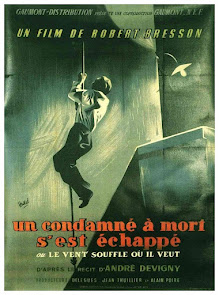Un condamné à mort s'est échappé ou Le vent souffle où il veut; drama / art-film, France, 1956, D: Robert Bresson, S: Francois Leterrier, Charles La Clainche, Maurice Beerblock, Jacques Ertaud
France during World War II. The occupational Nazi dictatorship shot 7,000 prisoners at the Montluc prison. French Resistance member Fontaine is held in this prison. He withholds an iron spoon after breakfast and uses it to chisel the wooden door of his cell. He removes three planks and is able to exit to the hallway, but returns them to the door before the guards show up. Upon hearing that he is sentenced to death, Fontaine decides to try to escape during that night, but is given an unknown cellmate, Jost. Even though he suspects Jost is an informer, Fontaine tells him about his escape plan and brings him with him. They use an improvised hook and rope to descend down the prison building, kill a prison guard in the back yard, and climb up the wall to freedom.
Included in Roger Ebert’s list of Great Movies, “A Man Escaped” is sometimes regarded as one of the highlights in Robert Bresson’s career, whose ‘ascetic’ and raw directing style blends in here remarkably well with traces of suspense, until it reaches a climax in the fascinating 20-minute escape sequence at the end that is both tranquil and full of intensity at the same time—almost as a “sedated Hitchcock”. This is probably one of the most influential art-films in the prison escape subgenre, since its structure and events were impersonated by numerous subsequent films. Bresson avoids any kind of sentimentality and even anxiety or depression, and is instead interested in an almost objective, concise, minimalist depiction of the prison break. He builds his story solely on great little details: the protagonist Fontaine uses the blunt side of an iron spoon to slowly carve out the frame of the wooden door, remove three planks from it, and exit the hallway at night.
Fontaine spots a chalk inscription on an inmate’s door, “Food forbidden”, and erases it, while his monologue explains how he was happy he could help him, and that he felt pleased while returning back to his cell and going asleep. Fontaine bends the metal for light fittings in his cell, makes a hook out of it, and holds on to it while the hook is attached to the bars on his window, to test if it can support his weight. The meticulous sequence in which he shreds his bedsheets, clothes and pillow case, and then knits a “rope-braid” out of it. The agonizing waiting for hours for the prison guard in the back yard to finally get away from the place where Fontaine intends to descend down the wall. Bresson is today not that well remembered because he was so conventional and simple in his approach—yet very few other conventional movies are able to be effective and sophisticated on such a high level while just focusing on its topic, whereas its themes here are practically universal (yearning for freedom to escape from misery; integrity even during hardship; salvation of the soul from hell). However, Bresson's de-dramatized, bland style is still a little bit overrated: everything here is done just right, and yet, watching a Bresson movie is like having a soup without salt. He simply lacks passion.
Grade:+++






No comments:
Post a Comment